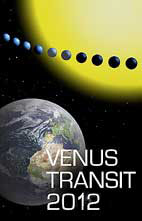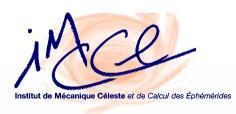
|


 |
2004-2012: the transits of Venus
|
Educational sheets for teachers, students and
amateur astronomers
One will find below the list of the educational
sheets. These sheets are available as html, word or pdf files. Some sheets are
dedicated to the 2004 transit and some to the 2012 transit.
- What is the interest of the transit of Venus
html & pdf
The calculations
- The prediction of the Venus transits:
a- geometry of the phenomenon (in french) for 2004: html
& pdf, and for 2012:
pdf
b- local conditions (in french) for 2004: html
& pdf and for 2012:
pdf
c- maps of the areas of visibility (in french) for 2004:
html
& pdf and for 2012:
pdf
- What will we observe on June 8, 2004?
html & pdf,
word
What we will observe on June 5-6, 2012? pdf (in french)
The local conditions for the transit of 2012 for each country concerned by the event:
pdf
- How to calculate the AU from the observation of
a transit?
a- definitions (in french) for 2004: html
& pdf and for 2012:
pdf
b- theory (in french) for 2004: html
& pdf and for 2012:
pdf
c- calculations (in french) for 2004: html
& pdf and for 2012:
pdf
- How to calculate yourself the AU:
a- a simplified method of calculation
html (with example from 2004) and
pdf (with example for 2012).
b- formulae for the calculations from the timings for 2004
html and for 2012:
pdf
c- formulae for the calculations from the distances
for 2004 html and for 2012:
et pour 2012 (in french):
pdf
d- an interactive application
allowing to calculate the parallax of the Sun from the observations of the 2012 transit.
- How to choose a partnership for calculating the AU from
two distant sites? (in french) for 2004: html
& pdf; and for 2012:
pdf
- How to send observations to VT-2012 network calculation
center in Paris? :html.
The Sun and Venus
- Our solar system and its members and its planetary laws
html & pdf
- Venus – the second planet in the solar system (an overview with physical data)
html & pdf
- Venus – the Earth’s sister planet (a comparison)
html & pdf
- Venus’ orbit and visibility – day, night and seasons on Venus
html & pdf
- Venus topography, geology and planetary history
html & pdf
- The clouds of Venus – a description of the planet’s atmosphere:
html
- Venus and mythology
html & pdf
- Venus and science fiction
html & pdf
- Life on Venus and on other worlds in the solar system?
html & pdf
- Space probes for mapping the planet Venus
html & pdf
- Information about the Sun
html & pdf
- Eclipses – the common and well-known kind of transit
The history
- History of the observations of transits of Venus:
a- the first predictions and the transits of 1631 and 1639: html
b- the transit of Venus of 1761: html
c- the transit of Venus of 1769: html
d- the transit of Venus of 1874: html
e- the transit of Venus of 1882: html
- List of the voyages made for the observations of the
transits of Venus in the past centuries: html
Other transits
- Other transits in the solar system – Mercury, Jupiter satellites and Charon
html & pdf
- Searching for other worlds by using the transit method:
html
The observations
- Methods, tools and techniques for transit observations:
html & pdf ,
word
- Observation of the Sun : techniques and methods
- Safety html
The concepts
- Measuring distances in the universe
a- the distances in the solar system: html
b- the distances in the universe: html & pdf
c- the definition of the astronomical unit: html
word
- What is light?
- What is time?
- What is Universal Time? html &
pdf
- The calculation of the astronomical unit from the observations of June 8:
a- the calculation in real time on June 8:
html
b- the definitive calculation of the astronomical unit using all the data:
html
|
|



